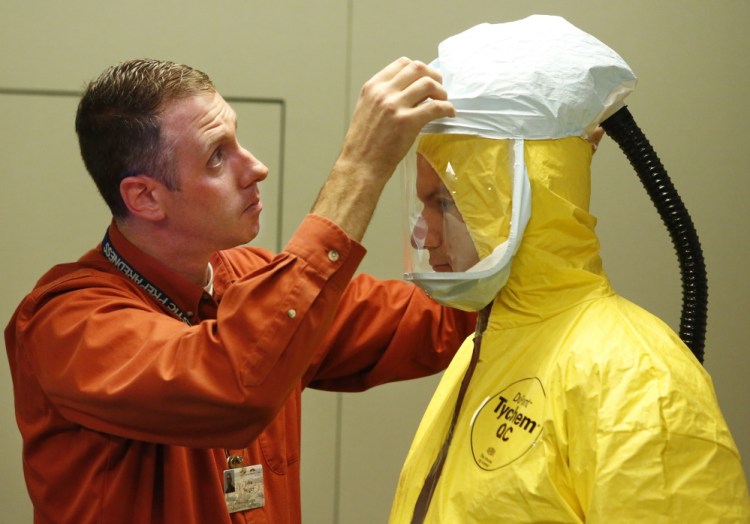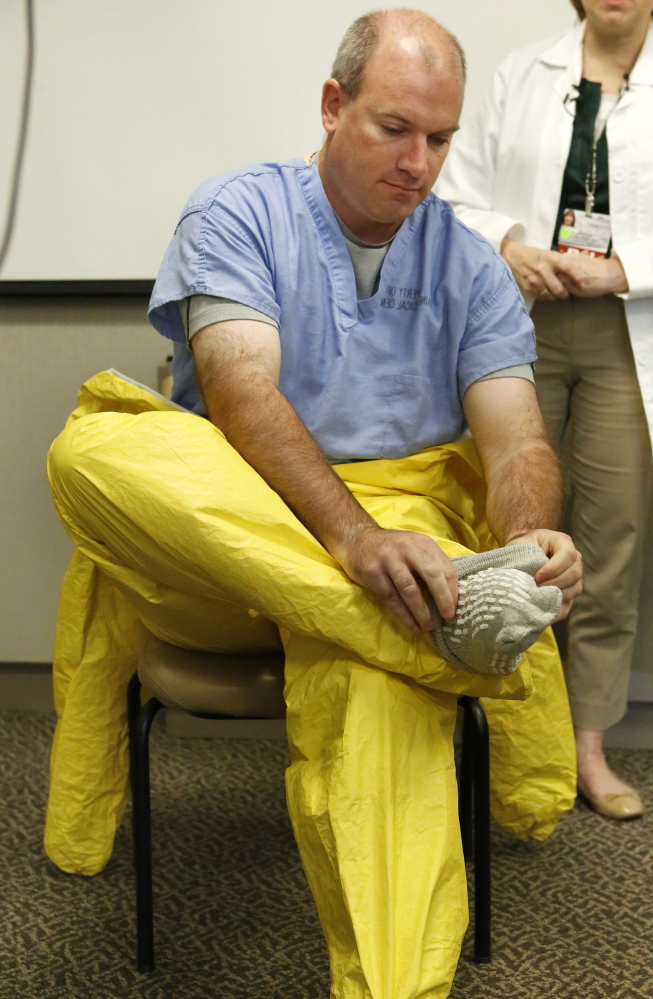Brian Dougher donned a yellow plastic suit, complete with slippers, two pairs of gloves and a mask. Then, with help from a Maine Medical Center co-worker, he duct-taped his wrists, neck and sternum, leaving no skin exposed. He breathed through a tube connecting the back of his mask and an air-purifying respirator carried on his back.
Eight days after Maine Med released a patient who had been monitored for Ebola before he tested negative for the disease, the hospital demonstrated its Ebola procedures to the media Wednesday in an effort to show the public that it is prepared to deal with potentially serious infectious disease outbreaks.
Maine Med officials said they have erred on the side of extreme caution, requiring, for example, that workers monitoring patients for Ebola have all skin covered even though the early U.S. Centers for Disease Control and Prevention guidelines did not require the full hazmat suit.
The federal agency strengthened its guidance Tuesday, reacting to the infection of two nurses who treated an Ebola patient in Dallas.
Maine Med is building four isolation rooms in its emergency department, adding to the two it already has, so that the hospital could treat up to six Ebola patients. The rooms would be useful for other infectious diseases, such as tuberculosis, SARS, Middle East respiratory syndrome or swine flu, hospital officials said.
When dressed in the hazmat suit, Dougher, the hospital’s emergency management coordinator, resembled a ripe, unpeeled banana.
It takes about 10 to 15 minutes to don and doff the full suit.
“It’s a very precise procedure,” said John Swiger, an industrial hygienist who assisted Dougher in the demonstration. “You don’t hurry through it.”
Maine Med officials said they took an aggressive stance when Ebola became a concern in the United States this summer. In August, the hospital adopted rigorous standards in line with the World Health Organization rules, which were stricter than the initial federal protocol. For instance, the early CDC guidelines did not require shoe coverings, permitted exposed skin on a worker’s neck and suggested one pair of gloves be used instead of two.
“Our thought was that the WHO has a lot more experience dealing with Ebola,” said Joshua Frances, Maine Med’s emergency management director. “You can never be too careful.”
The virus has killed more than 4,800 people in West Africa, nearly all in Liberia, Sierra Leone and Guinea. The disease migrated to the United States, killing the Texas patient and infecting two of his nurses. Ebola does not appear to be spreading in the United States, though news of the deadly disease has prompted public concern over whether public health agencies are capable of containing it.
The patient monitored and then released from Maine Med had a fever and had traveled to a “region of concern,” according to the Maine Center for Disease Control and Prevention. He was released after multiple tests showed he did not have the disease.
PRECAUTIONS DESPITE LOW RISK
“We don’t expect to have an epidemic in the U.S. The risk is fairly low,” said Dr. August Valenti, Maine Med’s infectious disease specialist. “Ebola is difficult to catch.”
In West Africa, many people live in close quarters and don’t have access to the public health infrastructure available in the United States, he said. That means family members of Ebola victims are left caring for sick relatives and can be exposed to the bodily fluids that carry the disease, he said.
The Ebola virus does not spread through the air, and the virus can be destroyed by household cleaners.
Still, it’s best to be prepared, and Valenti said the federal CDC’s early guidelines were not comprehensive.
“The initial recommendations were flimsy,” he said.
Texas Health Presbyterian Hospital in Dallas ended up unnecessarily risking the health of employees and people they came in contact with because the nurses treating the Ebola patient had skin exposed. Public health officials around the country have learned from the Ebola episode, experts say.
“I don’t think any hospital would be perfect at this point. But since Dallas, we’ve all learned a lot, and there’s a lot of room for improvement in preparedness for our health care systems,” said Jeffrey S. Duchin, a professor of infectious diseases at Washington University School of Medicine. “But it’s likely that (any Ebola cases) would be managed successfully at many hospitals today.”
ISOLATION, REMOTE MONITORING
Other hospitals in Maine, including Eastern Maine Medical Center in Bangor and Central Maine Medical Center in Lewiston, also have developed Ebola plans.
“We’re preparing for the worst, hoping that it never happens,” said Chuck Gill, vice president for public affairs at Central Maine Health Care.
It’s likely that any Ebola patients in the state would end up at Maine Med, however, given that it’s the state’s largest hospital and has the most resources for an emergency response.
The hospital’s four new isolation rooms will be connected to an anteroom, an airtight space where hospital workers can dress in hazmat gear. Frances, Maine Med’s emergency management director, didn’t immediately have an estimate on how much it would cost to build the isolation rooms.
The hospital now has two isolation rooms that are sealed off from the rest of the hospital and use “negative pressure” to keep clean air flowing through the rooms.
“We have dedicated air handlers constantly sucking air out of the room,” Frances said. “The air goes through filters and out of the hospital.”
While the two existing isolation rooms could be used if necessary, the new isolation areas would replace the current rooms unless there were more than four patients who needed to be isolated at one time.
Frances said Maine Med also will acquire patient monitoring equipment that can be controlled remotely, reducing the number of trips that nurses would have to make to an isolation room.
Every time a caregiver exits an isolation room, a co-worker also dressed in a hazmat suit is waiting. Both suits are decontaminated using alcohol-based wipes before they are taken off and placed in three disinfected bags. The bags are put into a box and shipped for incineration at a biohazard facility. Maine Med went through about 50 hazmat suits during the two days the patient was held for observation at the hospital.
In Texas, the hospital experienced problems with facilities refusing to accept the Ebola waste. If there were problems with disposal in Maine, Valenti said, the federal CDC would assist in its elimination.
Although he’s confident Maine Med has developed sound procedures, Valenti said the hospital will continue to “tweak” its plans. There is no reason for the public to panic, Valenti said.
“People were afraid,” he said. “We want people to calm down about this.”
Staff Writer Jennifer Van Allen contributed to this report.
Send questions/comments to the editors.





Comments are no longer available on this story